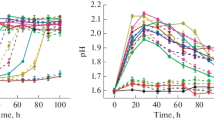Abstract
The toxicity of 15 flotation reagents (including xanthates, carbamates, thiophosphates, a mercaptobenzthiazole and a frothing reagent) used for concentrating sulfide minerals to five species of mineral-oxidising, moderately thermophilic and acidophilic microorganisms was assessed. The acidophiles tested included four bacteria (a Leptospirillum isolate, Acidimicrobium ferrooxidans, Acidithiobacillus caldus and a Sulfobacillusisolate) and one archaeon (a Ferroplasma isolate). There was wide variation both in terms of the relative toxicities of the different flotation reagents and the sensitivities of the microorganisms tested. In general, the dithiophosphates and the mercaptobenzothiol were the most toxic, while the Leptospirillum and Ferroplasma isolates were the most sensitive of the acidophilic microorganisms. The significance of these findings, in view of the expanding application of ore concentrates bioprocessing, is discussed.
Similar content being viewed by others
References
Brierley JA, Brierley CL (2001) Present and future commercial applications in biohydrometallurgy. Hydrometallurgy 59: 233–240.
Golyshina OV, Pivovarova TA, Karavaiko GI, Kondrat'eva TF, Moore ERB, Abraham WR, Lunsdorf H, Timmis KN, Yakimov MM, Golyshin PN (2000) Ferroplasma acidiphilum gen. nov., sp. nov., an acidophilic, autotrophic, ferrous-iron-oxidizing, cellwall-lacking, mesophilic member of the Ferroplasmaceae fam. nov., comprising a distinct lineage of the Archaea. Int. J. Syst. Evol. Microbiol. 50: 997–1006.
Hallberg KB, Johnson DB (2001) Biodiversity of acidophilic prokaryotes. Adv. Appl. Microbiol. 49: 37–84.
Loon HY, Madgwick J (1995). The effect of xanthate flotation reagents on bacterial leaching of chalcopyrite by Thiobacillus ferrooxidans. Biotechnol. Lett. 17: 997–1000.
Lovley DR, Phillips EJP (1987) Rapid assay for microbially reducible ferric iron in aquatic sediments. Appl. Environ. Microbiol. 53: 1536–1540.
Okibe N, Johnson DB (2001) Bioleaching of pyrite by defined mixed cultures of moderately thermophilic acidophiles. In: Ciminelli VST, Garcia Jr O, eds. Biohydrometallurgy: Fundamentals, Technology and Sustainable Development. Process Metallurgy 11A. Amsterdam: Elsevier, pp. 443–451.
Rawlings DE, ed. (1997) Biomining: Theory, Microbes and Industrial Processes. Georgetown, TX: Springer-Verlag/Landes Biosciences.
Rawlings DE, Tributsch H, Hansford GS (1999a) Reasons why Leptospirillum-like species rather than Thiobacillus ferrooxidans are the dominant iron-oxidizing bacteria in many commercial processes for the biooxidation of pyrite and related ores. Microbiology 145: 5–13.
Rawlings DE, Coram NJ, Gardner MN, Deane SM (1999b) Thiobacillus caldus and Leptospirillum ferrooxidans are widely distributed in continuous flow biooxidation tanks used to treat a variety of metal containing ores and concentrates. In: Amils R, Ballester A, eds. Biohydrometallurgy and the Environment toward the Mining of the 21st Century, Process Metallurgy 9A. Amsterdam: Elsevier, pp. 777–786.
Sand W, Gehrke T, Hallmann R, Schippers A (1995) Sulfur chemistry, biofilm, and the (in)direct attack mechanism: a critical evaluation of bacterial leaching. Appl. Microb. Biotechnol. 43: 961–966.
Tuovinen OH (1978) Inhibition of Thiobacillus ferrooxidans by mineral flotation reagents. Eur. J. Appl. Microbiol. Biotechnol. 5: 301–304.
Valdivia DNU, Chaves AP (2001) Influence of flotation compounds on the bioleaching process using Thiobacillus ferrooxidans. In: Ciminelli VST, Garcia Jr O, eds. Biohydrometallurgy: Fundamentals, Technology and Sustainable Development. Process Metallurgy 11A. Amsterdam: Elsevier, pp. 159–166.
Author information
Authors and Affiliations
Rights and permissions
About this article
Cite this article
Okibe, N., Johnson, D.B. Toxicity of flotation reagents to moderately thermophilic bioleaching microorganisms. Biotechnology Letters 24, 2011–2016 (2002). https://doi.org/10.1023/A:1021118915720
Issue Date:
DOI: https://doi.org/10.1023/A:1021118915720




